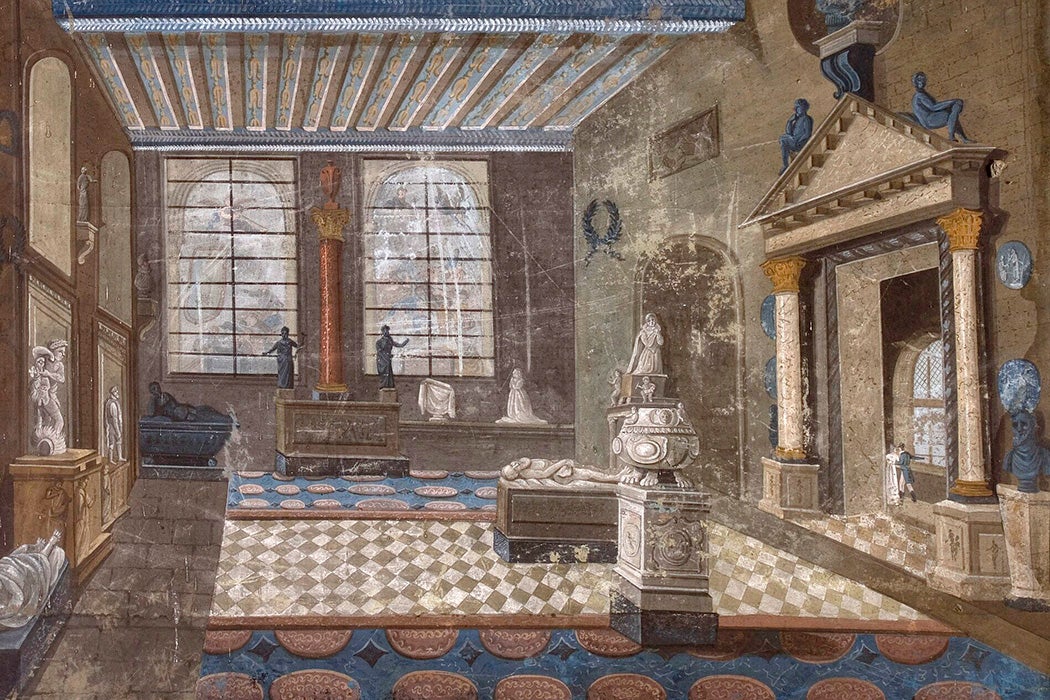Alexandre Lenoir’s Musée des monuments français was one of the first popular museums in Europe. Located in a Gothic convent only recently disestablished by the French Revolution, it must have been a curious experience. The collection was a hodgepodge of medieval and Renaissance material boldly rescued from the ravages of revolutionary chaos. It was mostly sculpture—enlivened, so to speak, by the purported remains of such monuments français as Descartes, Molière, La Fontaine, and legendary lovers Eloise and Abelard.
During the upheaval of the Revolution (1789–1799), “the arts were especially vulnerable to destruction,” writes art historian Christoper M. Greene. This was because the arts symbolized the “monarchy, the aristocracy, and the church, and were thus, in the eyes of the devout revolutionaries, symbols of oppression as opposed to freedom, of luxury as opposed to utility, and of mysticism as opposed to Reason.”
The period gave birth to the word vandalisme, after the notoriety of the Vandals sacking Rome in the fifth century. France’s palaces, chateaus, townhouses, cathedrals, monasteries, churches, tombs: all the edifices of the hated royal and feudal elite were potential targets of ransacking mobs. There’s no telling how much was destroyed or disappeared into obscurity, but there were vast storehouses of nationalized objects that were sold off to boost the republic’s shaky finances.
The British were big buyers of French culture—it was an antique collector’s fever dream, the ultimate Antiques Road Show. Meanwhile, whole buildings, like the abbey church of Cluny and the chateau of Anet, were turned into quarries, recycled for their stone, Greene explains. While the terrified monarchs of Europe were attempting to suppress the Revolution, French national defense meant that bronze statues were melted into canons and lead roofing turned into bullets.
Still, some things were saved. The Revolution’s “conflicting aims” of destruction and preservation swirled around Alexandre Lenoir (1761–1839), writes Greene. In 1790, Lenoir was a twenty-eight-year-old “undistinguished painter” whose former teacher happened to be serving on the Commission des arts. Gaining the support of the Commission, as well as the Mayor of Paris and the National Assembly, Lenoir was authorized in October 1790 to become the director of a depot of material rescued from religious institutions. The depot was located in the former convent of the Petits-Augustines (today part of the Beaux-Arts de Paris campus) on the left bank of the Seine. Most of what he got was sculpture—paintings were sent on to the Louvre.
Lenoir’s official remit was to plunder before the plunderers, taking things apart before the mob did. He attempted to rescue material from the Revolution, for the Revolution. And he was not just the administrator: he was often the collector general, too. He was, for instance, wounded in the hand while trying to prevent the mutilation of the corpse of Cardinal Richelieu (1585–1642) in the Sorbonne chapel. He didn’t succeed—soldiers displayed what remained of Richelieu’s head on a pike to the appreciative crowd—but he did eventually get the tomb itself transferred to the depot.
During the Terror (1773–1774), Lenoir “showed his mettle, his cunning, and his determination” in negotiating the fraught period with his head (completely) and his collection (mostly) intact. When representatives of the Committee of Public Safety showed up looking for metal for the national cause, Lenoir covered “his large bronze statues with a grayish distemper” to pass them off as marble.
Inspired by the different historical styles of tombs in the Basilica of Saint-Denis, where French kings had traditionally been buried, Lenoir proposed that the depot be turned into a museum to showcase the history of French art. The Musée was formally opened in 1796 and welcomed crowds for two decades.
Weekly Newsletter
“He had a comprehension of the integrity of the national culture and its connection with the national history which was unusual in its time,” writes Greene. Though “it would be going too far to claim that [Lenoir] initiated the development of a historical consciousness in France…he certainly played an important role in is encouragement.”
In 1816, the Bourbons, returned to power by the monarchies of Europe, shut down Lenoir’s museum. The collection was scattered, sent back to where it had come from or deposited in the Louvre and other museums. Some items still seem to be in the collection of the Beaux-Arts de Paris, the école where generations have learned about fine art.







